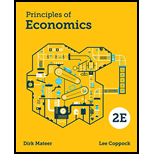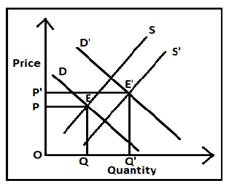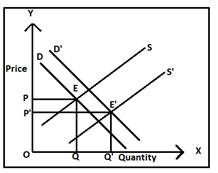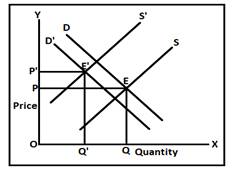
Combined effect of simultaneous changes in
Explanation of Solution
After the
1. If the demand and supply increase in the same proportion:
When demand and supply increase at equal rate, the equilibrium price remains unchanged but the equilibrium quantity changes. This is shown in the Figure 1. In the figure, equilibrium quantity has increased from OQ to OQ'
Figure 1

2. If the demand and supply decrease in the same proportion:
When demand and supply decrease at equal rate, the equilibrium price remains unchanged but the equilibrium quantity changes. This is shown in the Figure 2. In the figure, equilibrium quantity has decreased from OQ to OQ'

Figure 2
3. If the increase in demand is more than the increase in supply:
When the proportionate increase in the demand is greater than that of supply, then the equilibrium price increases a little while the equilibrium quantity increases greatly. This is shown in the Figure 3. In the figure, equilibrium price OP increases to OP' and the equilibrium quantity OQ increases to OQ'.
Figure 3

4. If the decrease in demand is more than the decrease in supply:
When the proportionate decrease in the demand is greater than that of supply, then the equilibrium price decreases a little while the equilibrium quantity decreases greatly. This is shown in the Figure 4. In the figure, equilibrium price OP decreases to OP' and the equilibrium quantity OQ decreases to OQ'.
Figure 4

5. If the increase in demand is less than the increase in supply:
When the proportionate increase in the supply is greater than that of demand, then the equilibrium price decreases a little while the equilibrium quantity increases greatly. This is shown in the Figure 5. In the figure, equilibrium price OP decreases to OP' and the equilibrium quantity OQ increases to OQ'.
Figure 5

6. If the decrease in demand is less than the decrease in supply:
When the proportionate decrease in the supply is greater than that of demand, then the equilibrium price decreases greatly while the equilibrium quantity increases a little. This is shown in the Figure 6. In the figure, equilibrium price OP increases to OP' and the equilibrium quantity OQ decreases to OQ'.
Figure 6

In all of the above figures,
D= Original demand curve, D'= New demand curve E= Equilibrium
S= Original supply curve, S'= New supply curve E= New Equilibrium
Introduction:
Market equilibrium take places at the momentwhen market demand and market supply become equal. This situation determines the equilibrium price, equilibrium quantity demanded and supplied also. After the market equilibrium is established, change in demand or supply as well as simultaneous changes in demand and supply at the same time affects the original equilibrium price, equilibrium quantity demanded and supplied. Sometimes these result in the establishment of a new market equilibrium.
Want to see more full solutions like this?
Chapter 3A Solutions
Principles of Economics (Second Edition)
- In an analysis of the market for paint, an economist discovers the facts listed below. State whether each of these changes will affect supply or demand, and in what direction. There have recently been some important cost-saving inventions in the technology for making paint. Paint is lasting longer so that property owners need not repaint as often. Because of severe hailstorms, many people need to repaint now. The hailstorms damaged several factories that make paint, forcing them to close down for several months.arrow_forwardWhen analyzing a market, how do economists deal with the problem that many factors that affect the market are changing at the same time?arrow_forwardDoes a price floor attempt to make a price higher or lower?arrow_forward


 Economics (MindTap Course List)EconomicsISBN:9781337617383Author:Roger A. ArnoldPublisher:Cengage Learning
Economics (MindTap Course List)EconomicsISBN:9781337617383Author:Roger A. ArnoldPublisher:Cengage Learning Principles of Economics 2eEconomicsISBN:9781947172364Author:Steven A. Greenlaw; David ShapiroPublisher:OpenStax
Principles of Economics 2eEconomicsISBN:9781947172364Author:Steven A. Greenlaw; David ShapiroPublisher:OpenStax Exploring EconomicsEconomicsISBN:9781544336329Author:Robert L. SextonPublisher:SAGE Publications, Inc
Exploring EconomicsEconomicsISBN:9781544336329Author:Robert L. SextonPublisher:SAGE Publications, Inc





